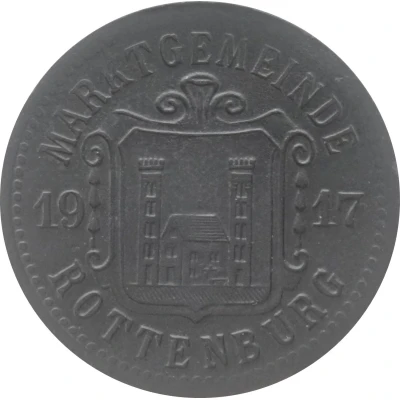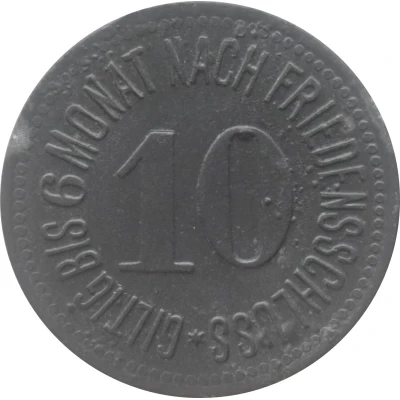


© Willem63 (CC BY-NC-SA)
10 Pfennigs - Rottenburg o. d. Laaber
1917 year| Zinc | 1.6 g | 20.0 mm |
| Issuer | Market Town of Rottenburg an der Laaber (Federal state of Bavaria) |
|---|---|
| Emperor | William II (Wilhelm II) (1888-1918) |
| Type | Standard circulation coin |
| Year | 1917 |
| Value | 10 Pfennigs (10 Pfennige) (0.10) |
| Currency | Mark (1914-1924) |
| Composition | Zinc |
| Weight | 1.6 g |
| Diameter | 20.0 mm |
| Thickness | 0.9 mm |
| Shape | Round |
| Technique | Milled |
| Orientation | Medal alignment ↑↑ |
| Demonetized | Yes |
| Updated | 2024-10-04 |
| Numista | N#351419 |
|---|---|
| Rarity index | 97% |
Reverse
Pearl rim, legend surrounding denomination.
Script: Latin
Lettering:
GILTIG BIS 6 MONAT NACH FRIEDENSSCHLUSS
10
✶
Edge
Plain
Interesting fact
One interesting fact about the 10 Pfennigs - Rottenburg o. d. Laaber 1917 coin is that it was issued during a time of economic turmoil in Germany, known as the "Inflationary Period" (1914-1923), when the value of the German mark was rapidly decreasing due to the country's involvement in World War I and the subsequent economic crisis. As a result, many different types of coins were issued during this time, including the 10 Pfennigs coin made of zinc, which was a cheaper alternative to traditional metals like silver or gold. Despite its low value, the coin remains a fascinating piece of history for collectors and numismatists today.